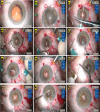Safety and efficacy of the Yamane technique for intraocular three-piece lens implantation in Egyptian patients diagnosed with Marfan syndrome: a retrospective study
- PMID: 39501192
- PMCID: PMC11536901
- DOI: 10.1186/s12886-024-03724-y
Safety and efficacy of the Yamane technique for intraocular three-piece lens implantation in Egyptian patients diagnosed with Marfan syndrome: a retrospective study
Abstract
Background: This study aimed to investigate the safety and efficacy of the Yamane technique (flanged intrascleral haptic fixation with double-needle technique /FIHFT) for three-piece intraocular lens (IOL) implantation in Egyptian patients diagnosed with Marfan syndrome (MFS) presented with subluxated lenses (ectopia lentis, EL).
Methods: This was a retrospective evaluation of thirty-three patients who were diagnosed with MFS and had subluxated lenses in a total of forty eyes. Seven of these patients had bilateral subluxation. Lensectomy or phacoemulsification was performed with limited anterior vitrectomy, followed by IOL implantation using the FIHFT method. Data was collected from medical records, including preoperative and postoperative corrected distant visual acuity (CDVA) using logarithm of the minimal angle of resolution (log MAR), preoperative and postoperative refractions, intraoperative and postoperative complications, and follow-up periods.
Results: The mean age of patients in the study was 30.79 years, with a mean follow-up of 23.9 months. Post-surgery, the refractive sphere decreased significantly from -9.1 ± 1.4 diopter (D) to -1.4 ± 0.7 D, and cylinder measurements dropped from -4.5 ± 0.8 D to -1.4 ± 0.6 D. The spherical equivalent (SEQ) also declined from -11.4 ± 1.5 D to -2.1 ± 0.8 D. The CDVA improved from 0.80 ± 0.32 to 0.18 ± 0.10 log MAR (P < 0.001). No intraoperative complications were identified. Postoperative complications included IOL decentration (12.5%), vitreous hemorrhage (7.5%), IOL slippage (5%), IOL tilt (5%), and retinal detachment (RD) (5%). Further surgical procedures were necessary for only four cases (10%), all of which had positive outcomes. IOL tilting and slippage occurring at average ages of 18 and 19 years, respectively. No other complications, such as hypotony, elevated intraocular pressure (IOP), corneal edema, iritis, IOL dislocation, cystoid macular edema (CME) or endophthalmitis, were reported.
Conclusions: The Yamane technique has proven effective and safe for treating subluxated lenses in Egyptian patients with Marfan Syndrome, resulting in improved visual acuity with minimal complications, mostly minor and manageable. Comprehensive fundus examinations before and after surgery are essential for promptly identifying retinal breaks and reducing the risk of retinal detachment. IOL tilting and slippage are more common in younger patients.
Keywords: Ectopia lentis; Lenticular astigmatism; Marfan syndrome; Scleral lens fixation; Yamane technique.
© 2024. The Author(s).
Conflict of interest statement
The authors declare no competing interests.
Figures




Similar articles
-
Outcomes of the flanged intrascleral haptic fixation with double-needle technique in patients with Marfan syndrome.Eur J Ophthalmol. 2022 Jul;32(4):2166-2172. doi: 10.1177/11206721211044636. Epub 2021 Sep 8. Eur J Ophthalmol. 2022. PMID: 34493106
-
Bimanual irrigation-aspiration for ectopia lentis and use of a small incision for 4-point scleral-sutured foldable intraocular lens and anterior vitrectomy in patients with Marfan syndrome.Indian J Ophthalmol. 2019 Oct;67(10):1629-1633. doi: 10.4103/ijo.IJO_250_19. Indian J Ophthalmol. 2019. PMID: 31546497 Free PMC article.
-
Risk factors for postoperative complications in lensectomy-vitrectomy with or without intraocular lens placement in ectopia lentis associated with Marfan syndrome.Br J Ophthalmol. 2014 Oct;98(10):1338-42. doi: 10.1136/bjophthalmol-2013-304144. Epub 2014 May 15. Br J Ophthalmol. 2014. PMID: 24831716
-
[Sutureless scleral intraocular lens fixation: report of nine cases and literature review].J Fr Ophtalmol. 2013 Oct;36(8):658-68. doi: 10.1016/j.jfo.2012.09.009. Epub 2013 Jul 25. J Fr Ophtalmol. 2013. PMID: 23891322 Review. French.
-
Secondary intraocular lens implantation using the flanged intrascleral fixation technique in pediatric aphakia: case series and review of literature.J AAPOS. 2020 Oct;24(5):286.e1-286.e6. doi: 10.1016/j.jaapos.2020.06.010. Epub 2020 Oct 9. J AAPOS. 2020. PMID: 33045378 Review.
References
-
- Coelho SG, Almeida AG. Marfan syndrome revisited: From genetics to clinical practice. Rev Port Cardiol (Engl Ed). 2020; Available from: 10.1016/j.repce.2020.04.004 - PubMed
-
- Chen Z, Zhang M, Deng M, Chen T, Chen J, Zheng J, et al. Surgical outcomes of modified capsular tension ring and intraocular lens implantation in Marfan syndrome with ectopia lentis. Eur J Ophthalmol. 2021;32(2):11206721211012868. Available from: 10.1177/11206721211012868. - PubMed
MeSH terms
LinkOut - more resources
Full Text Sources
Medical
Miscellaneous

